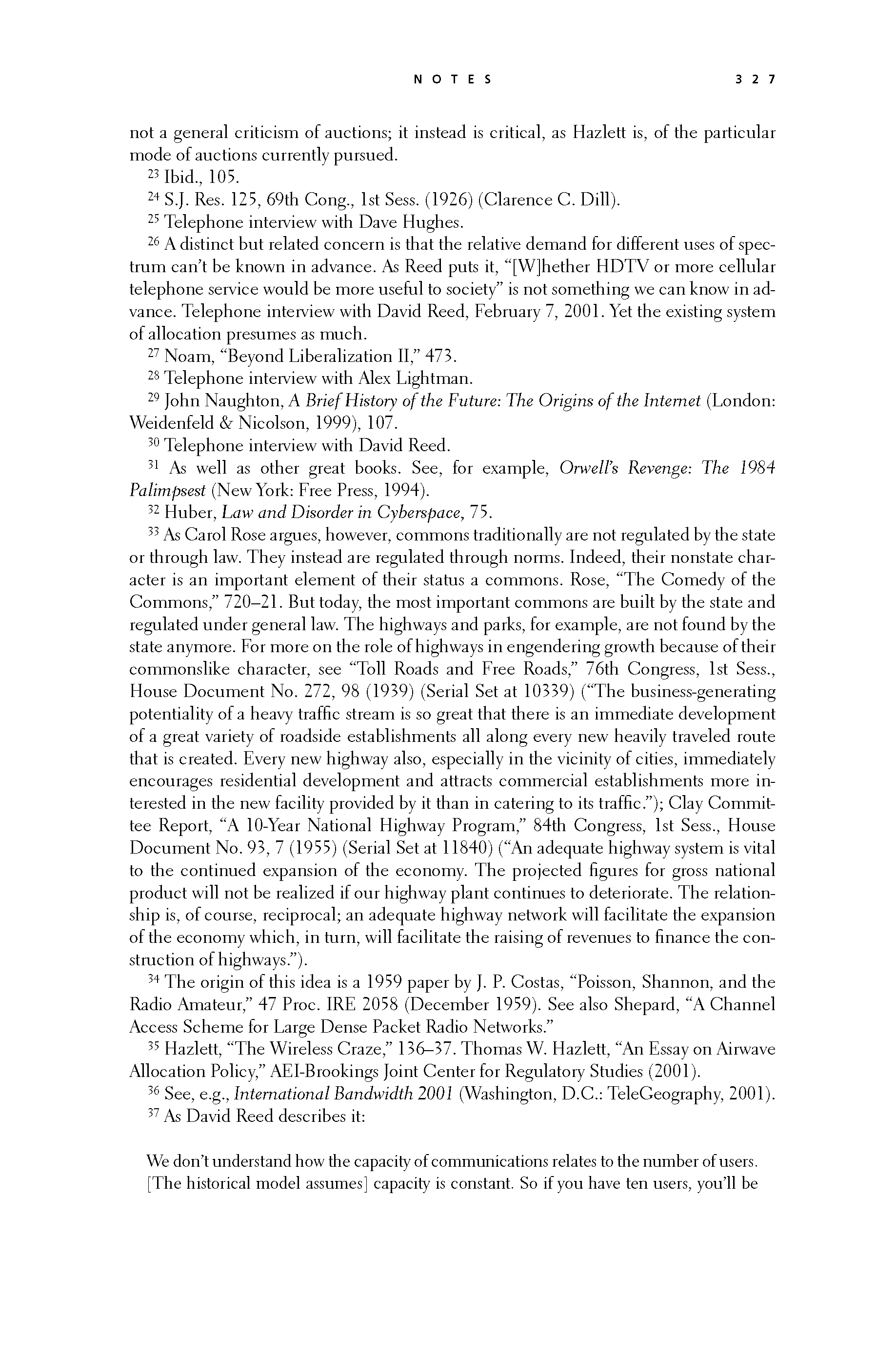 p326 _
-chap- _
toc-1 _
p327w _
toc-2 _
+chap+ _
p328
p326 _
-chap- _
toc-1 _
p327w _
toc-2 _
+chap+ _
p328
not a general criticism of auctions; it instead is critical, as Hazlett is, of the particular
mode of auctions currently pursued.
[12-23] Ibid., 105.
[12-24] S.J. Res. 125, 69th Cong., 1st Sess. (1926) (Clarence C. Dill).
[12-25] Telephone interview with Dave Hughes.
[12-26] A distinct but related concern is that the relative demand for different uses of spec-
trum can't be known in advance. As Reed puts it, "[W]hether HDTV or more cellular
telephone service would be more useful to society" is not something we can know in ad-
vance. Telephone interview with David Reed, February 7, 2001. Yet the existing system
of allocation presumes as much.
[12-27] Noam, "Beyond Liberalization II," 473.
[12-28] Telephone interview with Alex Lightman.
[12-29] John Naughton, _A_Brief_History_of_the_Future:_The_Origins_of_the_Internet_ (London:
Weidenfeld & Nicolson, 1999), 107.
[12-30] Telephone interview with David Reed.
[12-31] As well as other great books. See, for example, _Orwell's_Revenge:_The_1984_
_Palimpsest_ (New York: Free Press, 1994).
[12-32] Huber, _Law_and_Disorder_in_Cyberspace,_ 75.
[12-33] As Carol Rose argues, however, commons traditionally are not regulated by the state
or through law. They instead are regulated through norms. Indeed, their nonstate char-
acter is an important element of their status a commons. Rose, "The Comedy of the
Commons," 720-721. But today, the most important commons are built by the state and
regulated under general law. The highways and parks, for example, are not found by the
state anymore. For more on the role of highways in engendering growth because of their
commonslike character, see "Toll Roads and Free Roads," 76th Congress, 1st Sess.,
House Document No. 272, 98 (1939) (Serial Set at 10339) ("The business-generating
potentiality of a heavy traffic stream is so great that there is an immediate development
of a great variety of roadside establishments all along every new heavily traveled route
that is created. Every new highway also, especially in the vicinity of cities, immediately
encourages residential development and attracts commercial establishments more in-
terested in the new facility provided by it than in catering to its traffic."); Clay Commit-
tee Report, "A 10-Year National Highway Program," 84th Congress, 1st Sess., House
Document No. 93, 7 (1955) (Serial Set at 11840) ("An adequate highway system is vital
to the continued expansion of the economy. The projected figures for gross national
product will not be realized if our highway plant continues to deteriorate. The relation-
ship is, of course, reciprocal; an adequate highway network will facilitate the expansion
of the economy which, in turn, will facilitate the raising of revenues to finance the con-
struction of highways.").
[12-34] The origin of this idea is a 1959 paper by J. P. Costas, "Poisson, Shannon, and the
Radio Amateur," 47 Proc. IRE 2058 (December 1959). See also Shepard, "A Channel
Access Scheme for Large Dense Packet Radio Networks."
[12-35] Hazlett, "The Wireless Craze," 136-137. Thomas W. Hazlett, "An Essay on Airwave
Allocation Policy," AEI-Brookings Joint Center for Regulatory Studies (2001).
[12-36] See, e.g., _International_Bandwidth_2001_ (Washington, D.C.: TeleGeography, 2001).
[12-37] As David Reed describes it:
____ We don't understand how the capacity of communications relates to the number of users.
____ [The historical model assumes] capacity is constant. So if you have ten users, you'll be
[[327]]
p326 _
-chap- _
toc-1 _
p327w _
toc-2 _
+chap+ _
p328